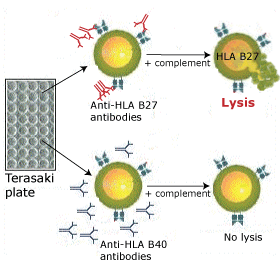HLA typing by serology
 |
| Example of a serological reaction. The lysis of the lymphocytes by a serum containing anti-HLA B27 anti-bodies denotes the HLA-B27 positivity of the cells. |
|
A complement-dependent cytotoxicity (CDC) test or microlymphocytotoxicity
assay for HLA typing has been developed in the 60’s.
Serology is still the method of choice in many laboratories for
low resolution typing
of HLA-A and HLA-B (discrimination between groups of related alleles only), owed to its simplicity and low cost. By contrast, molecular typing has almost entirely replaced the CDC for the
other HLA-loci (HLA-C, DR and DQ) for which serology is not precise enough.
The technique
Lymphocytes are tested with a
panel of sera containing well characterized HLA-specific alloantibodies. Each serum is placed in a microtiter well of a
Terasaki plate (60-72 wells/plate). After a short incubation, rabbit serum
is added as a source of complement and the cells that have bound the alloantibody are lysed making them permeable to
the fluorochrome ethidium bromide. The wells containing the lysed cells are easily discriminated by microscopy.
|



 Print
Print